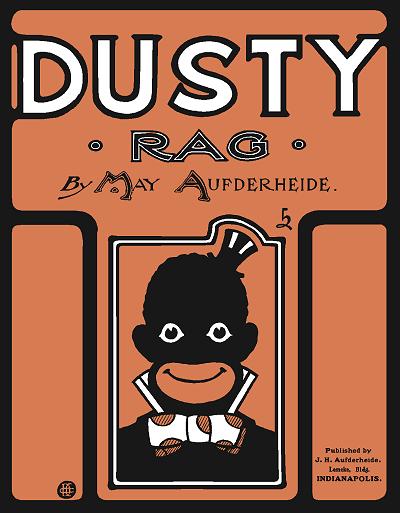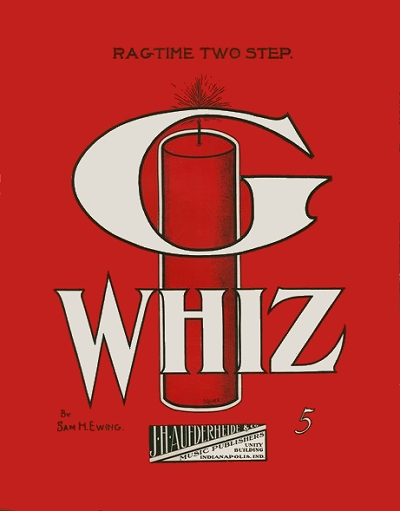From the love for a daughter who had such a passion for ragtime music that she simply could not stay away from it, sprang a small Indiana firm that ended up publishing some of the finer examples of Midwest ragtime before it disappeared in a flash. John Aufderheide didn't set out to make his name in publishing, as he was considered one of the finest investment brokers in Indianapolis. Born to German immigrant William J. Aufderheide and his Missouri born wife Elizabeth Wilch in Indiana's capitol city, John spent his entire life in the state slowly making a name for his family. His father was a cabinet maker and his uncle, who lived next door, a carpenter, both who were able to provide well for their loved ones.
John eventually was joined by a two younger brothers and sister, Charles (1870) who died in infancy, William (1871) and Mary (1876). During his years in school he became a very capable violinist, so was equipped with musical propensity and some background. His younger sister May (Kolmer) was also an accomplished pianist who performed with the Indianapolis Symphony and later taught at the Metropolitan School of Music.
After high school, John was employed for two years by the Indianapolis Banking Company while attending college. After two year there he went briefly into the retail coal business, then started his own loan and investment business in 1887, the Commonwealth Loan Company. John was married to Lucy Ann Deel on April 3 that same year. From 1889 on he was listed in Indianapolis directories and census records first as in loans and real estate, then later as a loan broker. But there was an event in the Aufderheide family that slowly turned their lives topsy turvy.
May Frances Aufderheide came into the Aufderheide home nearly a year after the couple wed. Her brother Rudolph followed in July of 1891. As befitting the family's rising position in society, John sent May to finishing school in her mid-teens, but evidently not enough finishing was done. May, who had received some lessons from her musical aunt while growing up, had a fascination with ragtime piano from the first time she heard it played.
As befitting the family's rising position in society, John sent May to finishing school in her mid-teens, but evidently not enough finishing was done. May, who had received some lessons from her musical aunt while growing up, had a fascination with ragtime piano from the first time she heard it played.
 As befitting the family's rising position in society, John sent May to finishing school in her mid-teens, but evidently not enough finishing was done. May, who had received some lessons from her musical aunt while growing up, had a fascination with ragtime piano from the first time she heard it played.
As befitting the family's rising position in society, John sent May to finishing school in her mid-teens, but evidently not enough finishing was done. May, who had received some lessons from her musical aunt while growing up, had a fascination with ragtime piano from the first time she heard it played.Applying her own talent and knowledge she started writing music down while on the east coast, and brought some rags back with her to Indianapolis in 1907. Her father wanted nothing to do with the nonsensical idea she had to publish these pieces, and hoped her focus could be diverted elsewhere. However, one of her friends, a sign painter named Cecil Duane Crabb, agreed to help May get her rag Dusty into print, and with the help of another friend, Paul Pratt, who did the engraving to accompany Crabb's cover image, Dusty was soon in print. Sadly, in the limited venues in which it was placed, Dusty quickly got rather dusty from lack of sales. After it was released, May was sent to tour Europe as many girls of well-to-do families were. Upon her return in 1908 she married young architect Thomas M. Kaufman on March 25 and they settled to the eastern part of the state in Richmond by year's end.
Just the same, she was still writing rags and trying to get another one into the stores. Her desire must have been compounded when her cousin Frieda Aufderheide had The Flyer Rag published. John saw that she was determined to write, and spurred on in part by her ability to publish a rag on her own and by growing sales of Dusty Rag, he formed J.H. Aufderheide & Company to publish his daughter's works. John bought the Dusty Rag copyright and reissued it under his label along with her Richmond Rag. It was successful enough to garner column space in the American Musician and Art Journal in the summer of 1909. They touted May Frances as a composer with a future, noted her two pieces that were currently in demand, and told of two more that were sure to be hits. They were Buzzer Rag and The Thriller, the latter which would become her best known work.
Although Cecil was retained for cover art work, he also published a couple of pieces with the firm, ultimately turning to art and sign painting as his profession. Paul, not yet 20, was hired as the manager and arranger for the Aufderheide company, as shown in the 1910 enumeration. One of his first rags for the firm was Colonial Glide. He later recalled that even though there has been no historical confirmation of contracts for those composers who were published by Aufderheide, that he received a 1.5 cent per copy royalty for this piece. The success of the firm from publicity, as well as additional composers in the stable like Will B. Morrison, Gladys Yelvington, Abe Olman and Julia Lee Niebergall, allowed J.H. Aufderheide to expand his enterprise with a second location in a better distribution hub, Chicago. He sent Pratt there to manage the new branch, with Niebergall taking over some of the arranging duties in Indianapolis.
May and her husband moved back to Indianapolis in 1911 in part because of his inability to retain work in the architecture field, and also to raise the daughter they had just adopted in a place where he had better income prospects. It was during that time that she finished her last published piano rag, Novelty Rag. With her brother Rudolph as lyricist, she also released the song You and Me in the Summertime. But the Aufderheide surge nearly ended there. The only issue from the Aufderheide company in 1912 was a song version of Dusty Rag which did not fare well. Unfortunately for all involved in the expanding company, fortunes quickly dried up. May lost her desire to continue on track with her well-crafted rags, and with sales suddenly slowing, her father also lost interest in continuing the company.
It was during that time that she finished her last published piano rag, Novelty Rag. With her brother Rudolph as lyricist, she also released the song You and Me in the Summertime. But the Aufderheide surge nearly ended there. The only issue from the Aufderheide company in 1912 was a song version of Dusty Rag which did not fare well. Unfortunately for all involved in the expanding company, fortunes quickly dried up. May lost her desire to continue on track with her well-crafted rags, and with sales suddenly slowing, her father also lost interest in continuing the company.
 It was during that time that she finished her last published piano rag, Novelty Rag. With her brother Rudolph as lyricist, she also released the song You and Me in the Summertime. But the Aufderheide surge nearly ended there. The only issue from the Aufderheide company in 1912 was a song version of Dusty Rag which did not fare well. Unfortunately for all involved in the expanding company, fortunes quickly dried up. May lost her desire to continue on track with her well-crafted rags, and with sales suddenly slowing, her father also lost interest in continuing the company.
It was during that time that she finished her last published piano rag, Novelty Rag. With her brother Rudolph as lyricist, she also released the song You and Me in the Summertime. But the Aufderheide surge nearly ended there. The only issue from the Aufderheide company in 1912 was a song version of Dusty Rag which did not fare well. Unfortunately for all involved in the expanding company, fortunes quickly dried up. May lost her desire to continue on track with her well-crafted rags, and with sales suddenly slowing, her father also lost interest in continuing the company.Louis Mentel, who headed Mentel Brothers Publishing in Cincinnati, bought the Aufderheide catalog in 1912, and had some success with reissues of the pieces he acquired, most of them piano rags. Out of a job and stranded in Chicago, Pratt was desperate to both seek good work and continue to compose and arrange, so he went to New York City where he contracted with some of the firms in Tin Pan Alley. Within a couple of years he moved back to Chicago for his music career. Mr. Kaufman eventually ended up working for John in at Commonwealth as a broker, and his marriage to May reportedly remained strained in spite of financial security. For the 1920 enumeration May was shown as having no occupation, not even teaching music.
Even from 1909 to 1912, during the heyday of Aufderheide Publishing, John still listed himself as a loan broker in local directories. He eventually shifted into the role of investment broker with his expanding company, which is how he is listed in the late 1910s through the early 1930s. John then retired in Washington, Indiana in the early 1930s. He and Lucy were still living there when the 1940 census was taken, with a maid and butler as part of the household. John passed on at age 76, just shy of the beginning of World War II and the subsequent traditional jazz and ragtime revival, in which Dusty Rag played a pretty good part. May and her family moved to California in the late 1940s. While the rags that came from his catalog are easy enough to find in reprinted editions, those covers that bear the unusual wedge Aufderheide logo designed by Crabb are still coveted by collectors, as are the rags themselves. If not for the father's love, we might not have ever enjoyed the daughter's musical passion.
Thanks go to researcher Terry Woods who helped uncover a few extra details about the Aufderheide family.

 Published Composers
Published Composers